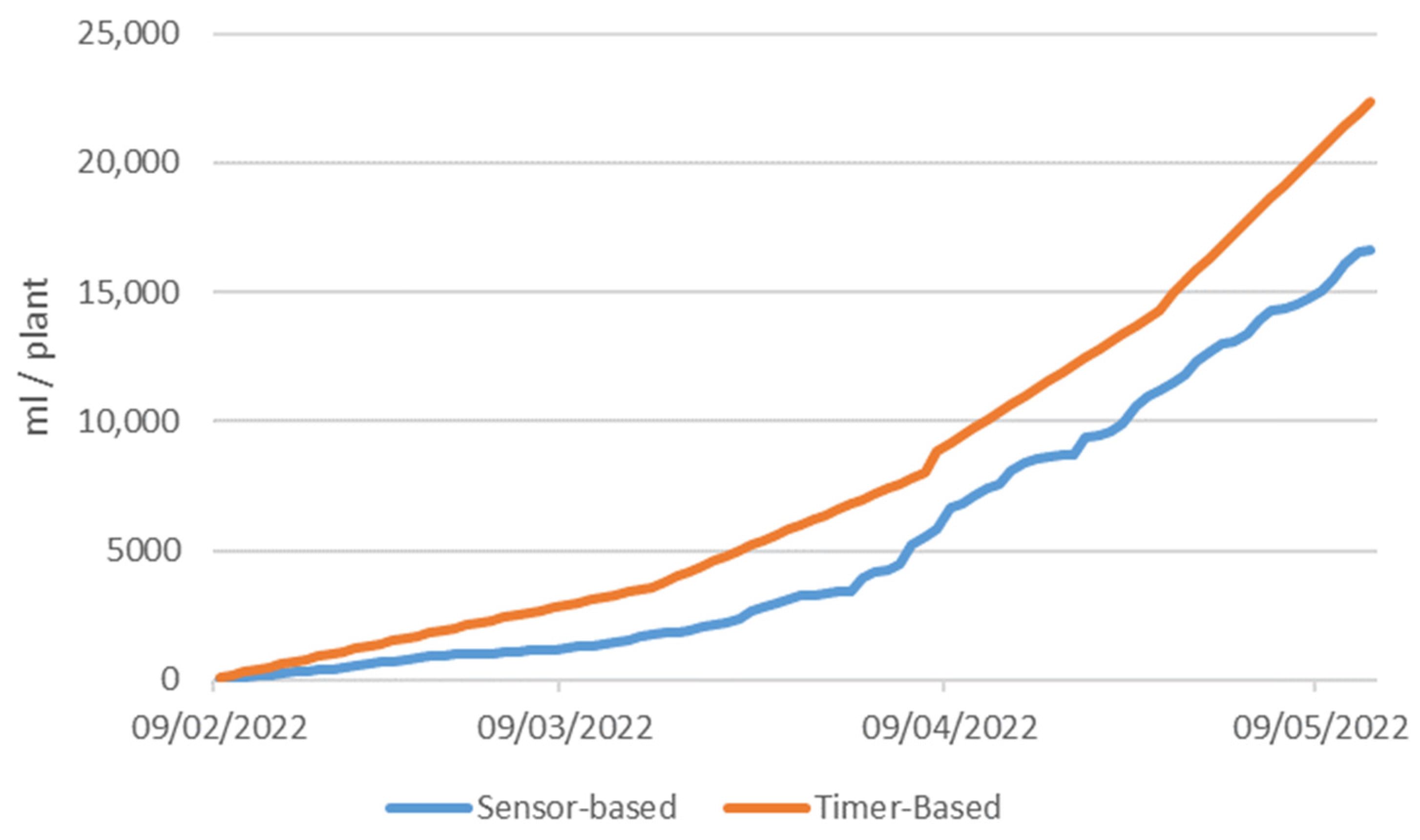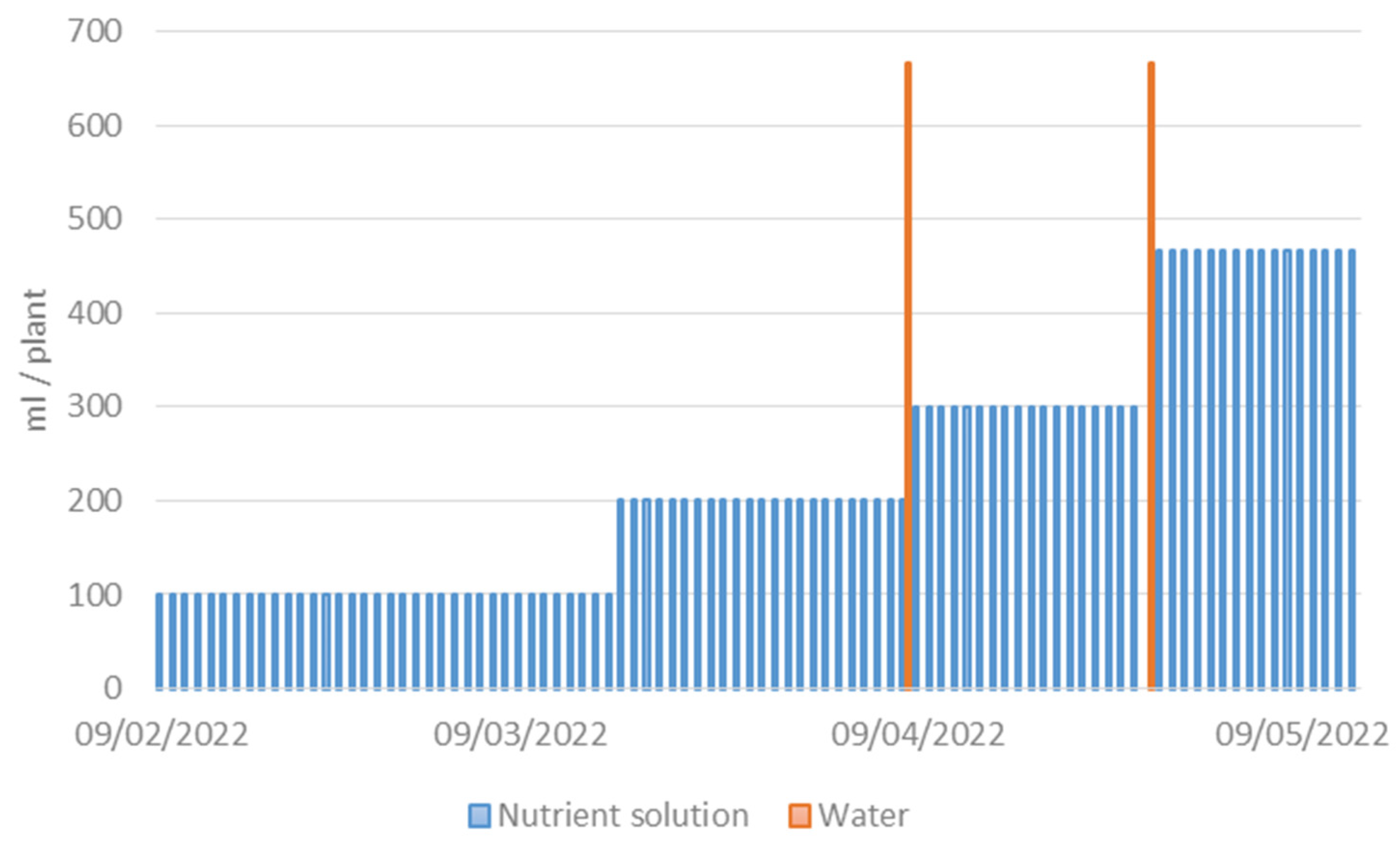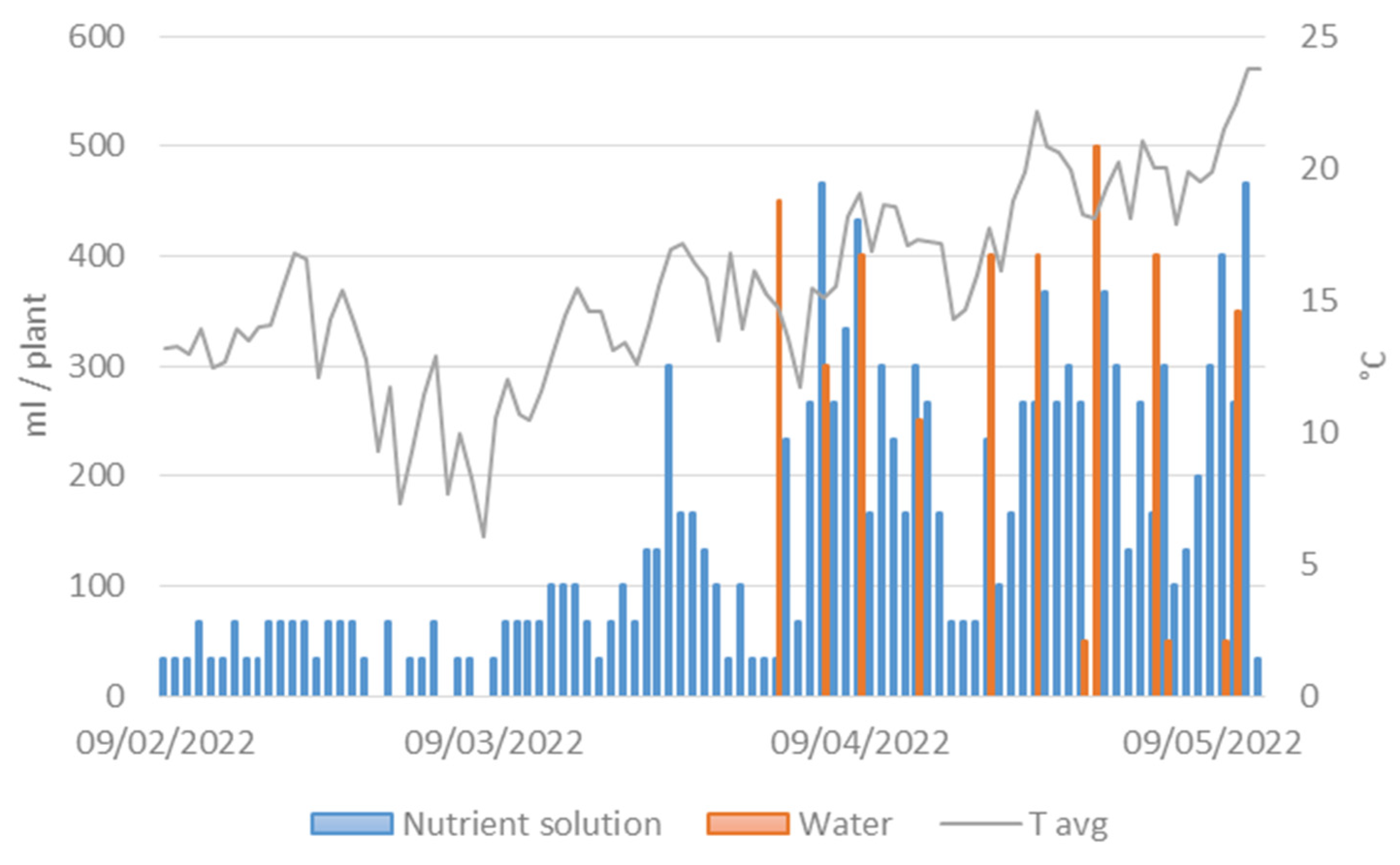Sensor-Based Fertigation Management Enhances Resource Utilization and Crop Performance in Soilless Strawberry Cultivation
Abstract
:1. Introduction
2. Materials and Methods
2.1. Plant Materials and Growing Conditions
2.2. Irrigation Treatments
2.3. Measurements
2.3.1. Water and NS Consumption
2.3.2. Yield and Quality
2.3.3. Water Use Efficiency and Nutrient Productivity
2.3.4. Plant Physiology and Growth Analysis
2.4. Statistical Analysis
3. Results and Discussion
3.1. Irrigation Consumption, VWC and EC
3.2. Plant Growth, Yield, Fruit Quality, WUE and PFP of Nutrients
4. Conclusions
Author Contributions
Funding
Data Availability Statement
Acknowledgments
Conflicts of Interest
References
- Galán-Martín, Á.; Vaskan, P.; Antón, A.; Esteller, L.J.; Guillén-Gosálbez, G. Multi-Objective Optimization of Rainfed and Irrigated Agricultural Areas Considering Production and Environmental Criteria: A Case Study of Wheat Production in Spain. J. Clean. Prod. 2017, 140, 816–830. [Google Scholar] [CrossRef]
- Li, M.; Xu, Y.; Fu, Q.; Singh, V.P.; Liu, D.; Li, T. Efficient Irrigation Water Allocation and Its Impact on Agricultural Sustainability and Water Scarcity under Uncertainty. J. Hydrol. 2020, 586, 124888. [Google Scholar] [CrossRef]
- Assouline, S.; Russo, D.; Silber, A.; Or, D. Balancing Water Scarcity and Quality for Sustainable Irrigated Agriculture. Water Resour. Res. 2015, 51, 3419–3436. [Google Scholar] [CrossRef]
- Calzadilla, A.; Rehdanz, K.; Tol, R.S.J. Water Scarcity and the Impact of Improved Irrigation Management: A Computable General Equilibrium Analysis. Agric. Econ. 2011, 42, 305–323. [Google Scholar] [CrossRef]
- Putra, P.A.; Yuliando, H. Soilless Culture System to Support Water Use Efficiency and Product Quality: A Review. Agric. Agric. Sci. Proc. 2015, 3, 283–288. [Google Scholar] [CrossRef]
- Wilfried, B.; Womdim, R.N.; Nebambi, L.; Alison, H.; Nicolás, C.; Cherubino, L.; De Pascale, S.; Muien, Q. Good Agricultural Pratices for Greenhouse Vegetable Crops: Principles for Mediterranean Climate Areas; Organisation des Nations Unies Pour L’alimentation et L’agriculture, Société Internationale de la Science Horticole, Centre National Pour la Recherche Agricole et la Vulgarisation, Eds.; FAO plant production and protection paper; FAO: Rome, Italy, 2013; ISBN 978-92-5-107649-1. [Google Scholar]
- Fussy, A.; Papenbrock, J. An Overview of Soil and Soilless Cultivation Techniques—Chances, Challenges and the Neglected Question of Sustainability. Plants 2022, 11, 1153. [Google Scholar] [CrossRef] [PubMed]
- Gruda, N. Increasing Sustainability of Growing Media Constituents and Stand-Alone Substrates in Soilless Culture Systems. Agronomy 2019, 9, 298. [Google Scholar] [CrossRef]
- Incrocci, L.; Thompson, R.B.; Fernandez-Fernandez, M.D.; De Pascale, S.; Pardossi, A.; Stanghellini, C.; Rouphael, Y.; Gallardo, M. Irrigation Management of European Greenhouse Vegetable Crops. Agric. Water Manag. 2020, 242, 106393. [Google Scholar] [CrossRef]
- Rahim Doust, J.; Nazarideljou, M.J.; Arshad, M.; Ferrante, A. Comparison of the Growth, Physio-Biochemical Characteristics, and Quality Indices in Soilless-Grown Strawberries under Greenhouse and Open-Field Conditions. Horticulturae 2023, 9, 774. [Google Scholar] [CrossRef]
- Sangiorgio, D.; Cellini, A.; Spinelli, F.; Donati, I. Promoting Strawberry (Fragaria × ananassa) Stress Resistance, Growth, and Yield Using Native Bacterial Biostimulants. Agronomy 2023, 13, 529. [Google Scholar] [CrossRef]
- Pergola, M.; Maffia, A.; Carlucci, G.; Persiani, A.; Palese, A.M.; Zaccardelli, M.; Altieri, G.; Celano, G. An Environmental and Economic Analysis of Strawberry Production in Southern Italy. Agriculture 2023, 13, 1705. [Google Scholar] [CrossRef]
- Palumbo, M.; D’Imperio, M.; Tucci, V.; Cefola, M.; Pace, B.; Santamaria, P.; Parente, A.; Montesano, F.F. Sensor-Based Irrigation Reduces Water Consumption without Compromising Yield and Postharvest Quality of Soilless Green Bean. Agronomy 2021, 11, 2485. [Google Scholar] [CrossRef]
- Palumbo, M.; Pace, B.; Cefola, M.; Montesano, F.F.; Serio, F.; Colelli, G.; Attolico, G. Self-Configuring CVS to Discriminate Rocket Leaves According to Cultivation Practices and to Correctly Attribute Visual Quality Level. Agronomy 2021, 11, 1353. [Google Scholar] [CrossRef]
- Nikolaou, G.; Neocleous, D.; Kitta, E.; Katsoulas, N. Advances in Irrigation/Fertigation Techniques in Greenhouse Soilless Culture Systems (SCS). In Advances in Horticultural Soilless Culture; Burleigh Dodds Science Publishing Limited: Cambridge, UK, 2021; pp. 249–275. ISBN 978-1-78676-438-6. [Google Scholar]
- Pardossi, A.; Malorgio, F.; Incrocci, L.; Carmassi, G.; Maggini, R.; Massa, D.; Tognoni, F. Simplified models for the water relations of soilless cultures: What they do or suggest for sustainable water use in intensive horticulture. Acta Hortic. 2006, 718, 425–434. [Google Scholar] [CrossRef]
- Massa, D.; Magán, J.J.; Montesano, F.F.; Tzortzakis, N. Minimizing Water and Nutrient Losses from Soilless Cropping in Southern Europe. Agric. Water Manag. 2020, 241, 106395. [Google Scholar] [CrossRef]
- Hernández-Martínez, N.R.; Blanchard, C.; Wells, D.; Salazar-Gutiérrez, M.R. Current State and Future Perspectives of Commercial Strawberry Production: A Review. Sci. Hortic. 2023, 312, 111893. [Google Scholar] [CrossRef]
- Montesano, F.F.; Van Iersel, M.W.; Boari, F.; Cantore, V.; D’Amato, G.; Parente, A. Sensor-Based Irrigation Management of Soilless Basil Using a New Smart Irrigation System: Effects of Set-Point on Plant Physiological Responses and Crop Performance. Agric. Water Manag. 2018, 203, 20–29. [Google Scholar] [CrossRef]
- Montesano, F.F.; Van Iersel, M.W.; Parente, A. Timer versus Moisture Sensor-Based Irrigation Control of Soilless Lettuce: Effects on Yield, Quality and Water Use Efficiency. Hortic. Sci. 2016, 43, 67–75. [Google Scholar] [CrossRef]
- Choi, K.-Y.; Choi, E.-Y.; Kim, I.S.; Lee, Y.-B. Improving Water and Fertilizer Use Efficiency during the Production of Strawberry in Coir Substrate Hydroponics Using a FDR Sensor-Automated Irrigation System. Hortic. Environ. Biotechnol. 2016, 57, 431–439. [Google Scholar] [CrossRef]
- Johnson, C.M.; Stout, P.R.; Broyer, T.C.; Carlton, A.B. Comparative Chlorine Requirements of Different Plant Species. Plant Soil 1957, 8, 337–353. [Google Scholar] [CrossRef]
- Canaj, K.; Parente, A.; D’Imperio, M.; Boari, F.; Buono, V.; Toriello, M.; Mehmeti, A.; Montesano, F.F. Can Precise Irrigation Support the Sustainability of Protected Cultivation? A Life-Cycle Assessment and Life-Cycle Cost Analysis. Water 2021, 14, 6. [Google Scholar] [CrossRef]
- Hilhorst, M.A. A Pore Water Conductivity Sensor. Soil Sci. Soc. Am. J. 2000, 64, 1922–1925. [Google Scholar] [CrossRef]
- Commission Regulation (EC) No 843/2002; Laying down the Marketing Standard for Strawberries and Amending Regulation (EC) No 899/87 2002. Publications Office of the European Union: Luxembourg, 2002.
- Teka, T.A. Analysis of the Effect of Maturity Stage on the Postharvest Biochemical Quality Characteristics of Tomato (Lycopersicon Esculentum Mill.) Fruit. Int. Res. J. Pharm. Appl. Sci. 2013, 3, 180–186. [Google Scholar]
- Dobermann, A. Nutrient Use Efficiency—Measurement and Management. In Fertilizer Best Management Practices: General Principles, Strategy for Their Adoption and Voluntary Initiatives Versus; International Fertilizer Industry Association: Paris, France, 2007; pp. 1–28. [Google Scholar]
- Datta, S.; Taghvaeian, S. Soil Water Sensors for Irrigation Scheduling in the United States: A Systematic Review of Literature. Agric. Water Manag. 2023, 278, 108148. [Google Scholar] [CrossRef]
- Van Iersel, M.W.; Chappell, M.; Lea-Cox, J.D. Sensors for Improved Efficiency of Irrigation in Greenhouse and Nursery Production. Horttechnology 2013, 23, 735–746. [Google Scholar] [CrossRef]
- Valdés, R.; Ochoa, J.; Franco, J.A.; Sánchez-Blanco, M.J.; Bañón, S. Saline Irrigation Scheduling for Potted Geranium Based on Soil Electrical Conductivity and Moisture Sensors. Agric. Water Manag. 2015, 149, 123–130. [Google Scholar] [CrossRef]
- Bañón, S.; Álvarez, S.; Bañón, D.; Ortuño, M.F.; Sánchez-Blanco, M.J. Assessment of Soil Salinity Indexes Using Electrical Conductivity Sensors. Sci. Hortic. 2021, 285, 110171. [Google Scholar] [CrossRef]
- Ferreira, J.F.S.; Liu, X.; Suarez, D.L. Fruit Yield and Survival of Five Commercial Strawberry Cultivars under Field Cultivation and Salinity Stress. Sci. Hortic. 2019, 243, 401–410. [Google Scholar] [CrossRef]
- Zahedi, S.M.; Abdelrahman, M.; Hosseini, M.S.; Hoveizeh, N.F.; Tran, L.-S.P. Alleviation of the Effect of Salinity on Growth and Yield of Strawberry by Foliar Spray of Selenium-Nanoparticles. Environ. Pollut. 2019, 253, 246–258. [Google Scholar] [CrossRef]
- Denaxa, N.-K.; Nomikou, A.; Malamos, N.; Liveri, E.; Roussos, P.A.; Papasotiropoulos, V. Salinity Effect on Plant Growth Parameters and Fruit Bioactive Compounds of Two Strawberry Cultivars, Coupled with Environmental Conditions Monitoring. Agronomy 2022, 12, 2279. [Google Scholar] [CrossRef]
- Amodio, M.; Attolico, G.; Bonelli, L.; Cefola, M.; Fazayeli, H.; Montesano, F.; Pace, B.; Palumbo, M.; Serio, F.; Stasi, A.; et al. Sustaining Low-Impact Practices in Horticulture through Non-Destructive Approach to Provide More Information on Fresh Produce History and Quality: The SUS&LOW Project. Adv. Hortic. Sci. 2023, 37, 123–132. [Google Scholar] [CrossRef]





| Treatments | Total Irrigation (NS + water, L plant−1) | NS Irrigation (L plant−1) | Water Irrigation (L plant−1) | Runoff (L plant−1) |
|---|---|---|---|---|
| TB | 22.4 | 21 | 1.3 | 4.5 |
| SB | 16.6 | 13 | 3.6 | 3.2 |
| Significance | -§ | -§ | -§ | -§ |
| TB | SB | Significance 1 | |
|---|---|---|---|
| Leaf chlorophyll content (μmol/mq) | 410 | 409 | ns |
| Leaf area (cm2) | 3090 | 2867 | ns |
| Plant dry matter (%) | 25 | 24 | ns |
| gsw (mol m−2 s−1) | 0.254 | 0.251 | ns |
| An (mol m−2 s−1) | 16.8 | 16.8 | ns |
| E (mmol m−2 s−1) | 6.13 | 6.10 | ns |
| TB | SB | Significance 1 | |
|---|---|---|---|
| Total fruits (g plant−1) | 308 | 332 | * |
| Marketable fruits (g plant−1) | 294 | 314 | * |
| TSS (°Brix) | 8.4 | 7.9 | ns |
| Dry matter (g 100 g−1 FW) | 9.1 | 9.2 | ns |
| Fruit firmness (N) | 4.1 | 4.2 | ns |
| Juice pH | 4.0 | 3.9 | ns |
| TA (g citric acid 100 mL−1 fruit juice) | 0.46 | 0.47 | ns |
| TB | SB | Significance 1 | |
|---|---|---|---|
| WUE (g L−1) | 13 | 19 | ** |
| PFP N (g FW g−1 N) | 154 | 268 | ** |
| PFP K (g FW g−1 K) | 128 | 223 | *** |
| PFP P (g FW g−1 P) | 768 | 1338 | ** |
| PFP Mg (g FW g−1 Mg) | 1023 | 1784 | *** |
| PFP Ca (g FW g−1 Ca) | 136 | 237 | ** |
| PFP S (g FW g−1 S) | 260 | 453 | *** |
Disclaimer/Publisher’s Note: The statements, opinions and data contained in all publications are solely those of the individual author(s) and contributor(s) and not of MDPI and/or the editor(s). MDPI and/or the editor(s) disclaim responsibility for any injury to people or property resulting from any ideas, methods, instructions or products referred to in the content. |
© 2024 by the authors. Licensee MDPI, Basel, Switzerland. This article is an open access article distributed under the terms and conditions of the Creative Commons Attribution (CC BY) license (https://creativecommons.org/licenses/by/4.0/).
Share and Cite
Bonelli, L.; Montesano, F.F.; D’Imperio, M.; Gonnella, M.; Boari, A.; Leoni, B.; Serio, F. Sensor-Based Fertigation Management Enhances Resource Utilization and Crop Performance in Soilless Strawberry Cultivation. Agronomy 2024, 14, 465. https://doi.org/10.3390/agronomy14030465
Bonelli L, Montesano FF, D’Imperio M, Gonnella M, Boari A, Leoni B, Serio F. Sensor-Based Fertigation Management Enhances Resource Utilization and Crop Performance in Soilless Strawberry Cultivation. Agronomy. 2024; 14(3):465. https://doi.org/10.3390/agronomy14030465
Chicago/Turabian StyleBonelli, Lucia, Francesco Fabiano Montesano, Massimiliano D’Imperio, Maria Gonnella, Angela Boari, Beniamino Leoni, and Francesco Serio. 2024. "Sensor-Based Fertigation Management Enhances Resource Utilization and Crop Performance in Soilless Strawberry Cultivation" Agronomy 14, no. 3: 465. https://doi.org/10.3390/agronomy14030465








